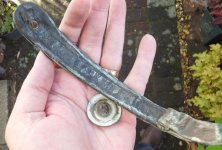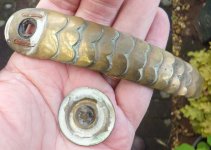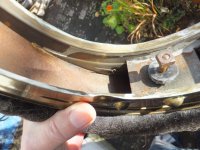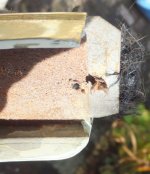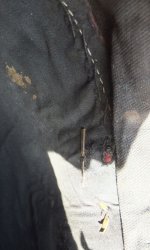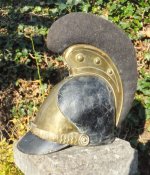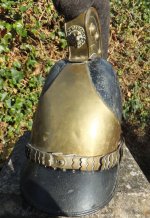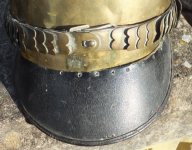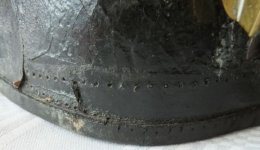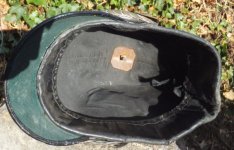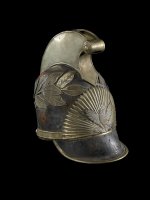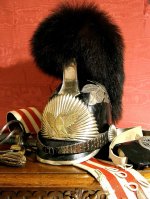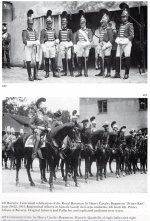Thanks for the links John. I see the resemblances in both Swiss and Swedish cases but the comb is wrong for the Swiss and the Swedish front plate extends all the way down to become the peak - which mine does not. Mine also has no rear visor because it is missing, the two lines of stitching there show where it once was but I have no idea of the correct shape. Found some time today to take it apart as much as possible and found no markings or stampings anywhere, just a horrible abundance of once liquid brass polish EVERYWHERE! It will take me a day to remove it all. (Really bad) pictures below but, first, a few observations.
1. The chinstrap is set on so that you cannot open the catch, the whole strap is simply fixed on too tightly to be opened as usual by raising it up the skull to gain some slack. the buckle behind it was properly fastened but the leather tongue is only about an inch and a half long, nowhere near long enough to actually function as a practical chinstrap. This chinstrap is real enough, made, and fitted, exactly as per a Haube but it seems to be decorative ONLY, unless some sort of leather 'extension was added to lengthen it?, but even if that was the case you STILL can't get enough 'play' to open it up and add the 'extra' strap.
2. The comb comes off after the central nut is removed. There is a very small split pin at the bottom end of the comb to pass through a hole in the back of the skull but the hole in the leather is crumbling away and it does not hold. The comb itself is brass outside with a thin sheet tin or steel inner core where the bolt is mounted. The three circular 'bosses' on each side of the comb are not embossed but seperate dome headed split pins passing through the sides. The whole comb is very solid and well made. The thick felted woollen Roach on the top is sewn into holes on the top with a coarse hemp-like string - some stitches gone but still holding quite well.
3. There are two types of stitching inside the skull (for both visors and the headband) : black in large diagonal stitches which in some places passes over lines of smaller horizontal (machine?) stitches in white. These are all concealed under the headband in its correct position and REALLY hard to photograph. Naturally the black looks older but it is hard to know for certain and the stitches where the rear visor used to be may not actually be functional all the way through.
4. The headband is, I think, oilcloth, very dirty but holding together well and there is a silk braided ribbon running through it.
5. I have not taken off the front plate as I am wary of breaking the large split pins. Besides, the brass is very thin so any stampings on the reverse would show through to the front and there are no signs of that.
I had a long conversation with a friend who is a curator at the Royal Armouries and he suggested contacting the Royal Army Museum as they are responsible for holding the uniforms and 'costume' element of the National collections. I am now thinking 'Clean and consolidate' rather than attempting some uninformed restoration work on that missing rear visor, at least until I can ID it with certainty.
If I get anywhere with my inquiries I will update this post, meantime thanks everyone who has commented, it is appreciated.
Steve.
Edit: Just remembered, there are the remains of what looks like buff coloured paper inside the skull in the last picture. I think this may have been a label- now long gone.
